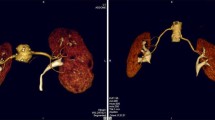Abstract
Computed tomography angiography (CTA) with multiple detecto-row CT (MDCT) has evolved into an established technique for non-invasive imaging of renal and mesenteric vessels. With adequate selection of acquisition parameters (thin collimation) high spatial-resolution volumetric data sets for subsequent 2D and 3D reformation can be acquired. Contrast medium (CM) injection parameters need to be adjusted to the acquisition speed of the scanners. Whereas fast acquisitions allow a reduction of total CM volume in the setting of CTA, this is not the case when CTA is combined with a second-phase abdominal MDCT acquisition for parenchymal (e.g., hepatic) imaging. Renal CTA is an accurate and reliable test for visualizing vascular anatomy and renal artery stenosis, and therefore a viable alternative to MRA in the assessment of patients with renovascular hypertension and in potential living related renal donors. CTA, combined with abdominal/parenchymal MDCT is a first-line diagnostic test in patients with suspected abdominal vascular emergencies, such as acute mesenteric ischemia, and an excellent tool to assess a wide variety of vascular abnormalities of the abdominal viscera.
Similar content being viewed by others
References
Safian RD, Textor SC (2001) Renal artery stenosis. N Engl J Med 334:431–42
Fleischmann D (2003) Use of high-concentration contrast media in multiple detector-row CT: principles and rationale. Eur Radiol
Hahn U, König CW, Miller S, Brehm B, Heuschmid M, Kopp AF et al. (2001) Multidetector CT angiography: Is it a valuable screening tool to detect significant renal artery stenosis? Rofo Fortschr Geb Rontgenstr Neuen Bildgeb Verfahr 173:1086–1092
Kaatee R, Beek FJ, de Lange EE, van Leeuwen MS, Smits HF, van der Ven PJ et al. (1997) Renal artery stenosis: detection and quantification with spiral CT angiography vs optimized digital subtraction angiography. Radiology 205:121–127
Awai K, Takada K, Onishi H, Hon S (2002) Aortic and hepatic enhancement and tumor-to-liver contrast: analysis of the effect of different concentrations of contrast material at multidetector-row helical CT. Radiology 224:757–763
Foley WD (2002) Special focus session: multidetector CT: abdominal visceral imaging. Radiographics 22:701–719
Kamel IR, Kruskal JB, Pomfret EA, Keogan MT, Warmbrand G, Raptopoulos V (2001) Impact of multidetector CT on donor selection and surgical planning before living adult right lobe liver transplantation. Am J Roentgenol 176:193–200
Author information
Authors and Affiliations
Corresponding author
Rights and permissions
About this article
Cite this article
Fleischmann, D. MDCT of renal and mesenteric vessels. Eur Radiol 13 (Suppl 5), 94–101 (2003). https://doi.org/10.1007/s00330-003-2103-5
Published:
Issue Date:
DOI: https://doi.org/10.1007/s00330-003-2103-5




